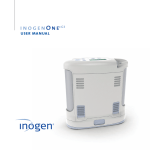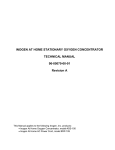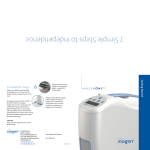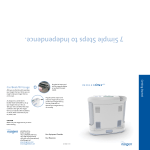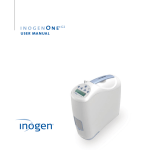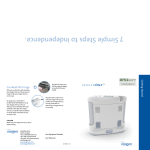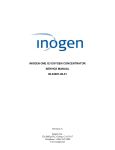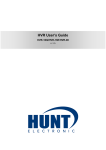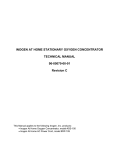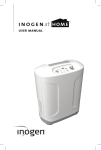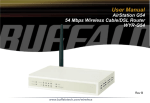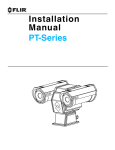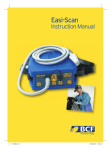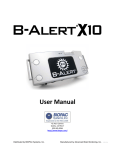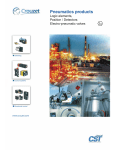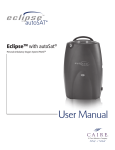Download Inogen One User Manual - Medical Supplies
Transcript
Patient Manual 36892_Manual.indd 1 6/5/06 10:08:32 AM 36892_Manual.indd 2 6/5/06 10:08:52 AM Introduction Introduction This Patient Manual will familiarize you with the Inogen One Oxygen Concentrator and its accessories. Be sure to thoroughly read all of the information in this Manual in its entirety. This Patient Manual may be available in additional languages. Contact your equipment provider if you would like to request this Manual in a different language. Application This Manual applies to the following Inogen, Inc. products: Inogen One Oxygen Concentrator, model # IO-100 AC Power Supply, model # BA-101 Mobile Power Charger, model # BA-106 Inogen One Battery, model # BA-100 Satellite Conserver, model # SC-100 External Battery Charger, model # BA-103 Inogen One Carry Bag, model # CA-102 Inogen One Cart and Carry Bag, model # CA-100 36892_Manual.indd 3 6/5/06 10:08:53 AM 36892_Manual.indd 4 6/5/06 10:08:53 AM Contents Chapter 1 01 Intended Use, Contraindications and General Precautions Chapter 2 03 03 04 05 06 07 08 Description of the Inogen One Oxygen Concentrator Important Parts of the Inogen One Oxygen Concentrator User Controls User Interfaces Input / Output Connections Power Supply Options Inogen One Accessories Chapter 3 11 11 16 Operating Instructions General Instructions Additional Operating Instructions Chapter 4 25 Inogen One Oxygen Concentrator Audible and Visible Signals (including Alarms) Chapter 5 35 35 37 Troubleshooting Inogen One Oxygen Concentrator Satellite Conserver Chapter 6 39 39 39 40 40 41 Cleaning, Care and Maintenance Cannula Replacement Case Cleaning Filter Cleaning and Replacement Regular Service and Maintenance Battery Care and Maintenance Chapter 7 43 Symbols Used on Concentrator and Accessories 36892_Manual.indd 5 6/5/06 10:08:53 AM 36892_Manual.indd 6 6/5/06 10:08:53 AM Intended Use, Contraindications and General Precautions 1 Intended Use The Inogen One Oxygen Concentrator is used on a prescriptive basis by patients requiring supplemental oxygen. It supplies a high concentration of oxygen and is used with a nasal cannula to channel oxygen from the concentrator to the patient. The Inogen One may be used in home, institution, vehicle and various mobile environments. CAUTION Federal law restricts this device to sale by or on the order of a physician. WARNING Availability of an alternate source of oxygen is required in case of power outage or mechanical failure. Consult your physician for type of back-up system required. NOTE It is the responsibility of the patient and/or provider to make back-up arrangements for alternative oxygen supply when traveling; Inogen assumes no liability for persons choosing not to adhere to manufacturer recommendations. Contraindications WARNING This device is NOT INTENDED to be life sustaining or life supporting. CAUTION Under certain circumstances, the use of non-prescribed oxygen therapy can be hazardous. This device should be used only when prescribed by a physician. Intended Use, Contraindications and General Precautions Chapter 1 36892_Manual.indd 7 1 6/5/06 10:08:54 AM CAUTION Additional monitoring or attention may be required for patients using this device who are unable to hear or see alarms or communicate discomfort. If the patient shows any signs of discomfort, a physician should be consulted immediately. CAUTION The Inogen One is not designed or specified to be used with a humidifier or nebulizer. Use of this device with a humidifier or nebulizer may impair performance and/or damage the equipment. CAUTION The Inogen One is designed to provide a flow of high purity oxygen. Patients with a fast breathing rate, requiring high oxygen flow, may require more oxygen than the Inogen One can produce, and therefore may not be suited for the Inogen One. General Precautions WARNING The device produces enriched oxygen gas which accelerates combustion. Do NOT ALLOW SMOKING OR OPEN FLAMES within 10 feet of this device while in use. WARNING Do not submerse the Inogen One or any of the accessories in liquid. Do not expose to water or precipitation. Do not operate in rain. This could lead to electrical shock and/or damage. CAUTION Do not use oil, grease, or petroleum-based products on or near the Inogen One. CAUTION Never leave the Inogen One in an environment which can reach high temperatures, such as an unoccupied car in high temperature environments. This could damage the device. 2 36892_Manual.indd 8 6/5/06 10:08:55 AM Description of the Inogen One Oxygen Concentrator 2 Important Parts of the Inogen One Oxygen Concentrator Particle Filter (on front panel) Flow Control Display Backlight Button On/Off Button Display Breath Detection Light Mode Button Alert/Alarm Light Description of the Inogen One Oxygen Concentrator Chapter 2 36892_Manual.indd 9 3 6/5/06 10:08:56 AM User Controls CAUTION The user controls on the Inogen One are specifically designed to be pressed by a finger. Never press any of the buttons with a pen, screwdriver, stylus, or any other object. NOTE Pressing the buttons with any hard, sharp and/or small object can damage the user controls. ON / OFF Button Press once to turn “ON”; Press and hold for one second to turn “OFF”. Mode Button Pressing this button will toggle the Inogen One’s breath detection alert on and off: 1. Default Mode. When the Inogen One is powered up, the breath detection alert is disabled. The display’s mode indication area is empty in Default Mode. 2. Breath Detection Alert Mode. The Inogen One will alert with audible and visual signals for “no breath detected” when this mode is enabled and no breath has been detected for 60 seconds. The display’s mode indication area will show a bell icon when the alert is enabled. Pressing and holding the button for five seconds will display the Inogen One life clock. 4 36892_Manual.indd 10 6/5/06 10:09:08 AM Flow Setting Control Buttons Use the up and down flow setting control buttons to select the setting as shown on the display. There are five settings, from 1 to 5. A sixth setting, “Satellite”, may be enabled if you have a Satellite Conserver. The Satellite Flow setting is designed to be used only with the Inogen Satellite Conserver. Call Inogen Customer Care at 1-877-4Inogen (1-877-446-6436) if you have a Satellite Conserver and wish to enable the Satellite setting. Display Backlight Button Push on; automatically turns off. User Interfaces Display This screen displays information regarding: flow setting, power status, battery life and errors. Indicator Lights Colored lights indicate either a change in operating status or a condition that may need response (alarm). Priority by color is red, yellow, then green. A flashing light is higher priority than non-flashing. Audible Signals An audible signal (beep) indicates either a change in operating status or a condition that may need response (alarm). More frequent beeps indicate higher priority conditions. Description of the Inogen One Oxygen Concentrator Chapter 2 36892_Manual.indd 11 5 6/5/06 10:09:12 AM Input / Output Connections Particle Filter The filter must be in place at the intake end of the concentrator during operation to keep input air clean. Cannula Nozzle Fitting The nasal cannula connects to this nozzle for Inogen One output of oxygenated air. DC Power In Connection for DC power connection from the AC Power Supply or Mobile Power Charger. Infrared Data Port Stored operation data can be transmitted to an external infrared communications port (located within the ratings label) by service personnel. This feature is not intended for patient use. 6 36892_Manual.indd 12 6/5/06 10:09:18 AM Power Supply Options Inogen One AC Power Supply The AC Power Supply enables the Inogen One to be connected to a normal U.S. standard (110V) electrical outlet (globally compatible: 100 to 240V, 50 to 60Hz with appropriate foreign outlet adapter). The Power Supply senses the AC electrical current and converts it into DC voltage, which powers the concentrator. When the Inogen One is connected to AC power, the battery will charge. Rechargeable Lithium Ion Battery The battery will power the Inogen One without connection to an external power source. When fully charged, the battery will provide 2 to 3 hours of operation. The battery recharges when properly installed in the Inogen One and the concentrator is connected to AC power. Recharging time is approximately 3 hours. See information in the “Battery Care and Maintenance” section. The battery can also be recharged using the External Battery Charger. Mobile Power Charger The Mobile Power Charger enables the Inogen One to be operated in an automobile or other vehicle with a DC output or a cigarette lighter adapter. The Mobile Power Charger supplies 18VDC power to operate the concentrator and to charge the onboard battery. When the Inogen One is connected to DC power, the battery will charge. See additional instructions included in the System for traveling with the Inogen One and the Mobile Power Charger. Description of the Inogen One Oxygen Concentrator Chapter 2 36892_Manual.indd 13 7 6/5/06 10:09:49 AM Inogen One Accessories* WARNING Do not use power supplies/adapters or accessories other than those specified in this Patient Manual. The use of non-specified accessories may create a safety hazard and/or impair equipment performance. Nasal Cannula A nasal cannula must be used with the Inogen One to provide oxygen from the concentrator. A single lumen cannula seven feet in length or less must be used to ensure proper breath detection and oxygen delivery. Satellite Conserver The Satellite Conserver enables use up to distances of 100 feet from the Inogen One Oxygen Concentrator. External Battery Charger The External Battery Charger allows you to charge additional batteries. This is especially useful if you are planning an extended outing away from electrical power and have more than one battery. * Actual appearance of accessories may vary. 8 36892_Manual.indd 14 6/5/06 10:10:05 AM External Battery Charger Power Supply The External Battery Charger Power Supply plugs into an AC outlet and powers your External Battery Charger. WARNING Do not use the External Battery Charger Power Supply to power your Inogen One. This may create a safety hazard and/or impair equipment performance. Carry Bag The Carry Bag provides a protective cover and shoulder strap to enable you to carry the Inogen One. Pockets are provided for carrying accessories. The Inogen One can be operated using battery power during transport with the Carry Bag. Cart The Cart has wheels and a telescoping handle to provide easy transport of the Inogen One. The Inogen One can be operated using battery power during transport. Description of the Inogen One Oxygen Concentrator Chapter 2 36892_Manual.indd 15 9 6/5/06 10:10:17 AM 36892_Manual.indd 16 6/5/06 10:10:42 AM Operating Instructions 3 General Instructions 1. Place the Inogen One in a well ventilated location. Air intake and exhaust must have clear access. Exhaust Locate the Inogen One in such a way that any auditory alarms may be heard. Intake WARNING Avoid use of the Inogen One in presence of pollutants, smoke or fumes. Do not use the Inogen One in presence of flammable anesthetics, cleaning agents or other chemical vapors. CAUTION Do not operate in temperatures below 41ºF (5ºC) or above 104ºF (40ºC) for extended amounts of time. CAUTION Do not obstruct air intake or exhaust when operating the device. Blockage of air circulation or proximity to a heat source may lead to internal heat buildup and shutdown or damage to the concentrator. CAUTION Be aware that electrical cord and/or tubing on the floor could present a tripping hazard. NOTE It is recommended the Inogen One be used in an upright position whenever possible. Operating Instructions Chapter 3 36892_Manual.indd 17 11 6/5/06 10:10:43 AM 2. Ensure the particle filter is in place. CAUTION Do not operate the Inogen One without the particle filter in place. Particles drawn into the system may damage the equipment. CAUTION The particle filter is placed ONLY in the front end of the Inogen One where air is drawn into the unit. Do not place a filter in the other end of the unit; this will restrict exhaust and may lead to overheating. 3. Install the battery. Open the battery door and insert the Inogen One Battery with the handle of the battery up. Press firmly to make sure the battery is in the correct position. Close the battery door. CAUTION The Inogen One battery acts as a secondary power supply in the event of a planned or unexpected loss of the AC or DC external power supply. When operating the Inogen One from an AC or DC external power supply, a properly inserted Inogen One battery should be maintained in the unit. This procedure will ensure uninterrupted operation and will operate all alarms and alerts in the event of a loss of the external power supply. 12 36892_Manual.indd 18 6/5/06 10:10:56 AM CAUTION Do not put hand or foreign objects into the battery well. NOTE The battery requires an initial AC charging of 3 hours to condition the battery. Do not run the Inogen One on battery power alone until this initial charging has been completed. 4. Connect the AC Power Supply. Connect the AC Power Cord to the AC Power Supply. Connect the AC Power Supply to the Inogen One. Plug into a nearby AC outlet. (A beep will sound.) CAUTION Do not place anything in the AC Power Supply port other than the supplied wall cord. Avoid the use of electrical extension cords with the Inogen One. If an extension cord must be used, use an extension cord that has an Underwriters Laboratory (UL) Mark and a minimum wire thickness of 18 gauge. Do not connect any other devices to the same extension cord. NOTE When the AC Power Supply is disconnected from the AC outlet, also disconnect it from the concentrator to avoid unnecessary battery discharge. 5. Connect the nasal cannula tubing to the nozzle fitting. Nozzle fitting is located next to the handle of the Inogen One. Use only a single lumen cannula with a length of 7 feet or less. Operating Instructions Chapter 3 36892_Manual.indd 19 13 6/5/06 10:11:15 AM CAUTION To ensure oxygen flow, ensure that the nasal cannula is properly connected to the nozzle fitting and that the tubing is not kinked or pinched in any way. CAUTION Replace the nasal cannula on a regular basis. Check with your Equipment Provider or physician to determine how often the cannula should be replaced. CAUTION To ensure proper breath detection and oxygen delivery, do not use additional tubing length exceeding 7 feet. 6. Turn on your Inogen One by pressing the ON/OFF Button. A single short beep will sound after the Inogen logo is displayed. “Please Wait” will appear while the concentrator starts up. The display will indicate the selected flow setting and power condition. Following a brief start-up sequence, a warm up period up to 30 minutes will initiate. During this time period the oxygen concentration is building to, but may not have reached, specification. However, the Inogen One can and should be used immediately. Additional warm up time may be needed if your Inogen One has been stored in extremely cold temperatures. NOTE Following a change in flow setting, the concentrator will adjust to the new conditions. Alerts and some error messages will be temporarily disabled. Continue to use the Inogen One normally. 14 36892_Manual.indd 20 6/5/06 10:11:31 AM NOTE When the Inogen One is turned on, it will be set to the same flow setting that it was in when it was turned off. However, if the Inogen One was in the Satellite setting when turned off or if no setting was detected, the Inogen One will start in Setting 3 when turned on. 7. Set the Inogen One Concentrator to the flow rate prescribed by your physician. Use the up or down setting buttons to adjust the Inogen One to the desired setting. The current setting can be viewed on the display. CAUTION The Inogen One must not be operated in the “Satellite” flow setting without use of the Satellite Conserver. Operation at this setting without the conserver will lead to reduced oxygen concentration and a system error. 8. Position the nasal cannula on your face and breathe through your nose. The Inogen One will sense the onset of inhalation and deliver a burst of oxygen at a precise time when you inhale. The Inogen One will sense each breath and continue to deliver oxygen in this manner. As your breathing rate changes, the Inogen One will sense these changes and deliver oxygen only as you need it. At times, if you inhale very quickly between breaths the Inogen One may ignore one of the breaths, giving the appearance of a missed breath. This may be normal as the Inogen One senses and monitors the changes in your breathing pattern. The Inogen One will normally sense the next breath and deliver oxygen accordingly. Operating Instructions Chapter 3 36892_Manual.indd 21 15 6/5/06 10:11:44 AM A green light will flash each time a breath is detected. Make certain that the nasal cannula is properly aligned on your face and you are breathing through your nose. WARNING If you begin to feel ill or are experiencing discomfort while using this device, consult your physician immediately. CAUTION Inhale through your nose for the concentrator to work most effectively. Inhaling through your mouth may result in less effective oxygen therapy. CAUTION The Inogen One is designed to provide a flow of high purity oxygen. An advisory alarm, “Oxygen Low”, will inform you if oxygen concentration drops. If alarm persists, contact your Equipment Provider. Additional Operating Instructions Mobile Power Charger – for Auto/RV/Boat travel To use the Inogen One while traveling in an automobile, plug the Mobile Power Charger into the cigarette lighter outlet or DC outlet, then plug in the Inogen One. Make sure the Inogen One is secure before operating the automobile or other vehicle. CAUTION When powering the Inogen One in an automobile with the Mobile Power Charger, ensure that the engine is running. Operating the device without the engine running may drain the car battery. 16 36892_Manual.indd 22 6/5/06 10:11:46 AM Battery Operation Battery operation allows you to be away from a power source (if the Inogen One is being powered by any of the external power options, a battery does not need to be installed for use). Ensure that the battery is in place and charged. Disconnect the Inogen One from its power source. While the Inogen One is operating on battery power, the battery will discharge. The display will indicate the estimated remaining percentage (%) or minutes of use. When the concentrator detects that the battery life is below 10% remaining, a low priority alert will sound. When the battery is empty, the alert will change to a high priority. When battery life is low, do one of the following: • Plug the Inogen One into an AC power source • Replace the battery with a charged battery after turning off the Inogen One (by pressing the ON/OFF button) • Attach the Mobile Power Charger • If the battery is drained, charge the battery or remove it from the concentrator. Leaving a deeply drained battery in the Inogen One for extended periods may cause the battery to not function properly If the Inogen One is being powered by the AC Power Supply or Mobile Power Charger, batteries will charge during operation. Leaving your Inogen One plugged in past the 3 hour charge time will not harm the concentrator or the battery. The Inogen One battery run time in Satellite mode is similar to setting 5: approximately 2 hours. Operating Instructions Chapter 3 36892_Manual.indd 23 17 6/5/06 10:11:54 AM Initial Battery Charging The Inogen One Battery requires an initial 3 hours of uninterrupted charging from an empty state using either the Inogen One or the External Battery Charger. Do not run the Inogen One on battery power until this initial charging has been completed. Normal Battery Charging To ensure that your battery is properly charging, inspect that the correct AC power adapter is being used and that the adapter is properly inserted into the power outlet. Observe the display or lights that indicate charging status. System Configuration Charge Time Battery installed in Inogen One; Powered by AC power supply 3 hours Battery installed in Inogen One; Powered by Mobile Power Charger 3 hours Battery installed in External Battery Charger 3 hours NOTE Battery charging times noted above are with the concentrator not running. Add 1 to 3 hours of charging time with concentrator running depending on flow setting. NOTE When starting to charge a fully discharged battery, the charging process may start and stop during the first few minutes. NOTE Attempting to charge a battery while running the Inogen One in elevated temperatures may lead to a “Remove Battery To Cool” message on the display and termination of battery charging. This will not affect operation of the Inogen One. 18 36892_Manual.indd 24 6/5/06 10:11:55 AM NOTE If the Inogen One has been operated on battery power only, the battery may be too hot to charge immediately. Remove the battery from the concentrator and let it cool for 10 minutes prior to charging. Battery Run Time Management Independence can be achieved through proper battery run time management. By combining the use of the AC Power Supply, the Mobile Power Charger, and the Inogen One Battery, you may stay away from your home almost indefinitely, when other types of devices require returning home to replace or refill the oxygen supply. You are never further from a supplemental supply of oxygen with your Inogen One than you are from a source of electric power. As an illustration of Battery Run Time Management, imagine a day in the life of oxygen user “Mae”: Time Period Activity Power Source Battery Level * 6:00-8:30 AM Wake Up / Breakfast AC Power Supply 100% 8:30-8:50 AM Drive to store Mobile Power Charger 100% 8:50-9:30 AM Shopping Battery Power 65% 9:30-9:50 AM Drive to friend’s home Mobile Power Charger 70% 9:50-12:00 PM Visit with friend AC Power Supply 100% 12:00-12:15 PM Drive to lunch date Mobile Power Charger 100% 12:15-1:30 PM Battery Power** 40% Leisurely lunch Operating Instructions Chapter 3 36892_Manual.indd 25 19 6/5/06 10:11:55 AM Battery Run Time Management (continued) Time Period Activity Power Source Battery Level * 1:30-4:00 PM Drive to visit family Mobile Power Charger 80% 4:00-5:00 PM Play with grandson Battery Power 30% 5:00-7:00 PM Dinner with family AC Power Supply 75% 7:00-9:00 PM Visit with family AC Power Supply 100% 9:00 PM - Sleep at family’s house AC Power Supply 100% 6:00-8:30 AM Wake Up / Breakfast AC Power Supply 100% 8:30-8:50 AM Drive to church Mobile Power Charger 100% 8:50-10:30 AM Church service Battery Power 15% 10:30-1:00 PM Drive back home Mobile Power Charger 55% 1:00-5:00 PM Bridge game & lunch with friends AC Power Supply 100% 5:00-5:30 PM Get mail & chat with neighbor outside Battery Power 75% 5:30-6:30 PM Spontaneous dinner at neighbor’s home Battery Power 25% 6:30 - Read & watch TV before going to bed AC Power Supply 100% 6:00 AM * Assuming high power usage rate (setting 4); conservative battery level at end of time period ** Many restaurants may make AC power accessible upon request 20 36892_Manual.indd 26 6/5/06 10:11:56 AM As can be seen from the previous table, proper battery management can, in many cases, allow you to remain away from home for entire days or longer without stress or concern of running out of oxygen. Users who require lower flow settings or who carry a second charged battery may experience even greater flexibility than seen in the above example. Travel When traveling with the Inogen One Oxygen Concentrator, be sure to bring the AC Power Supply, the Mobile Power Charger and the External Battery Charger (if you have one) with you. It is advisable to use external power whenever it is available in order to keep the internal battery in the Inogen One fully charged. See additional instructions in the “Traveling With Your Inogen One” guide. Consider use of the Carry Bag and Cart for transporting the Inogen One. CAUTION A change in altitude (for example, from sea level to mountains) may affect total oxygen available to the patient. Consult your physician before traveling to higher or lower altitudes to determine if your flow settings should be changed. Satellite Conserver If you have a Satellite Conserver, call Inogen Customer Care at 1-877-4-Inogen (1-877-446-6436) to configure the Inogen One for use with the Satellite Conserver. The Satellite Conserver enables use of the Inogen One by placing the concentrator in one location and connecting additional lengths of tubing. Place the concentrator in the desired location and power with the AC Power Supply. Operating Instructions Chapter 3 36892_Manual.indd 27 21 6/5/06 10:11:56 AM Attach the desired length of supply tubing (25 to 100 feet) to the hose nozzle on the Inogen One and to the “SUPPLY” hose nozzle on the Satellite Conserver. Inogen recommends that you do not use swivel connectors or extensions in your tubing while using the Satellite Conserver as this may cause a breach in pressure and cause a leak. Attach the cannula to the “CANNULA” hose nozzle on the Satellite Conserver. Turn the concentrator “ON” and adjust the flow setting on the concentrator to “Satellite”. Turn the Satellite Conserver “ON” by turning the rotary switch to the prescribed flow setting. A brief beep will sound and the indicator light will come on briefly. Place the Satellite Conserver in your pocket, around your shoulder or neck with the provided strap or attach to your belt. The light during startup indicates battery status: green if the battery is good; yellow when marginal; red when it should be immediately replaced. The light will show no light during normal operation, when the conserver is turned “OFF” or when the battery is completely dead. If more than 30 seconds elapses between breath detections, the Satellite Conserver will produce a single beep. This may indicate a tubing connection problem. NOTE Unlike the concentrator, the green light does not flash each time a breath is detected. 22 36892_Manual.indd 28 6/5/06 10:12:04 AM The Satellite Conserver uses a “C” size alkaline battery, which may last up to 4 weeks when used 8 hours per day. It can be replaced by turning “OFF” the conserver, sliding open the battery panel on the back of the conserver, removing the old battery and installing the new battery using the orientation shown inside the battery compartment. When it is likely that the Satellite Conserver will not be used for some time, remove the battery. CAUTION It is suggested that an extra “C” size battery is kept available for the Satellite Conserver. CAUTION Avoid using the Satellite Conserver with extended tubing lengths in any setting where the tubing may be unexpected to others and may present a tripping hazard. External Battery Charger – to charge an extra battery. Plug the External Battery Charger into a 110 VAC electrical outlet. A solid red light indicates that it is plugged in and is ready to begin charging. Charging time is approximately 3 hours. Slide the battery down and then firmly press into place to ensure a good connection. A flashing green light means the battery is charging. A solid green light indicates the battery is fully charged. A flashing red light indicates an error. CAUTION Avoid touching the recessed electrical contacts of the External Battery Charger; damage to contacts may affect charger operation. NOTE These contacts are not powered unless a battery is in place and charging. Operating Instructions Chapter 3 36892_Manual.indd 29 23 6/5/06 10:12:31 AM 36892_Manual.indd 30 6/5/06 10:12:49 AM Inogen One Oxygen Concentrator Audible and Visible Signals Display Icons 4 Mode Power Text The Inogen One display is divided into three areas. The upper left corner of the display shows the breath detection alert status. The lower left corner indicates power source and battery charge level. The right side of the display contains text information, such as flow setting, battery time remaining, and error notifications. Power Status Icons These icons are examples of those shown in the display’s power status window when the Inogen One is operating on battery power. Icon Meaning Battery is empty. Battery has less than 10% charge remaining. This icon flashes. Battery has approximately 40% to 50% charge remaining. Battery is full. Audible and Visible Signals Chapter 4 36892_Manual.indd 31 25 6/5/06 10:12:49 AM Power Status Icons (continued) The icons below are examples of those shown when the Inogen One is operating from an external power supply and charging the battery. The lightning bolt indicates that an external power supply is connected. Icon Meaning Battery is charging with charge level less than 10%. Battery is charging with charge level between 60% and 70%. The battery is fully charged and is charging as necessary to maintain its charge. The Inogen One is operating from an external power source with no battery present. Mode Icons These are the icons shown in the display’s mode window. Icon Meaning The breath detection alarm has been enabled. 26 36892_Manual.indd 32 6/5/06 10:12:51 AM Icon [blank] Meaning The concentrator is in the standard breath detect mode, and the breath detection alert is disabled. This is the default condition. Display Text NOTE When two conditions occur simultaneously, the condition with the higher priority will be displayed. Informational Messages The following information displays are not accompanied by any audible feedback or any visual change in the indicator lights. Message Display & Text Condition/Action/Explanation The Inogen logo is displayed at startup. Setting X (or) Satellite Battery HH:MM Default display when operating on battery power. “X.X” represents the selected flow setting (e.g., Setting 2). “HH:MM” represents the approximate time remaining on the battery charge (e.g., 1:45). Audible and Visible Signals Chapter 4 36892_Manual.indd 33 27 6/5/06 10:12:52 AM Informational Messages (continued) Message Display & Text Condition/Action/Explanation Setting X (or) Satellite Charging xx% (or) Battery Full Default display when operating on an external power supply and the battery is charging. “xx%” represents the percent battery charge (e.g., 86%). Setting X (or) Satellite Battery xx% Default display when the battery is not charging or when the time remaining is not available from the battery. Charging xx% (0r) Battery Full Display when the concentrator is plugged in and being used to charge a battery (not being used for oxygen production). Notifications The following notification messages are accompanied by a single, short beep. Message Display & Text Condition/Action/Explanation Inogen One Shutting Down On/Off button has been pressed for two seconds. Concentrator is performing system shut down. HH:MM Vxx.x ######## Mode button has been pressed for five seconds. Display shows the unit life clock, the software version, and the eight digit serial number (display will revert to the default in 10 seconds). 28 36892_Manual.indd 34 6/5/06 10:12:53 AM Low Priority Alerts The following low priority alert messages are accompanied by a double beep and a solid yellow light. Message Display & Text Condition/Action/Explanation External Power Low External power supply is too low to run the unit, which is running on battery power despite being plugged in. Check external power supply connections. If condition persists, contact your Equipment Provider. External Power High External power supply is too high. Check external power supply connections. If condition persists, contact your Equipment Provider. Battery Low Attach Plug Battery power is low, with less than 10% remaining. Attach external power supply or power down and insert a fully charged battery. Battery Error See Manual Battery error has occurred. Switch to a new battery or remove battery and operate concentrator using external power supply. If battery error recurs with same battery, stop using the battery and contact your Equipment Provider. Oxygen Low See Manual Concentrator is producing oxygen at a slightly low level. If condition persists, contact your Equipment Provider. Audible and Visible Signals Chapter 4 36892_Manual.indd 35 29 6/5/06 10:12:54 AM Low Priority Alerts (continued) Message Display & Text Condition/Action/Explanation Remove Battery to Cool Battery has exceeded its charging temperature and charging has stopped. The battery will not charge while this alert is present but will begin to charge when the battery temperature returns to the normal operating range. If battery charging is desired sooner, remove the battery from the concentrator and allow it to cool in an open area for approximately 10-15 minutes. Then, re-insert the battery into the Inogen One. If the problem still persists, contact your Equipment Provider. Maximum Flow Exceeded Satellite Conserver is being used and oxygen concentration is below desired level. If shortness of breath occurs, reduce activity level or change to a backup oxygen source. If condition persists, contact your Equipment Provider. Comm Error See Manual Concentrator is producing oxygen but cannot report battery status. Replace battery. If condition persists, contact your Equipment Provider. Service Needed The concentrator requires servicing at the earliest convenience. The concentrator is operating to specification and may continue to be used. Contact your equipment provider to arrange for service. 02 Sensor Fail See Manual The concentrator’s oxygen sensor has malfunctioned. You may continue to use the concentrator. If the condition persists, contact your equipment provider. 30 36892_Manual.indd 36 6/5/06 10:12:54 AM Medium Priority Alerts The following medium priority alert messages are accompanied by a triple beep, repeated every 25 seconds, and a flashing yellow light. Message Display & Text Condition/Action/Explanation Battery HOT Warning Battery has exceeded temperature limit while concentrator is running on battery power. If possible, move concentrator to a cooler location or power unit with an external power supply and remove battery. If condition persists, contact your Equipment Provider. No Breath Detect Check Cannula Concentrator is not detecting a breath. Check that: cannula is connected to concentrator, there are no kinks in tubing, and cannula is positioned properly in your nose. If Satellite Conserver is attached, make sure flow control on concentrator is set to Satellite Mode. Check Tubing Connections Check tubing and cannula connections. Assure proper flow setting if Satellite Conserver is not being used. System Error See Manual Concentrator is experiencing an error, but is capable of continued operation. As soon as you are able: • Remove and re-insert battery, and/or • Check external power supply connections. If condition persists, contact your Equipment Provider. Oxygen Error Service Needed Oxygen output concentrator is below 50%. If condition persists, switch to your backup oxygen source and contact your equipment provider to arrange for service. Audible and Visible Signals Chapter 4 36892_Manual.indd 37 31 6/5/06 10:12:55 AM High Priority Alerts CAUTION If you are not near the Inogen One you may not be able to hear or see the high priority alerts. Make sure the Inogen One is in a location where the alerts and alarms will be recognized if they occur. The following high priority alert messages are accompanied by a five beep pattern, repeated every 10 seconds, and a flashing red light. Message Display & Text Condition/Action/Explanation Battery Empty Attach Plug Concentrator has insufficient battery power to produce oxygen. Attach external power supply or exchange battery, then restart unit if necessary by pressing On/Off button. Battery HOT Shut Down Battery has exceeded temperature limit while concentrator is running on battery power. Concentrator has stopped producing oxygen. If possible, move concentrator to a cooler location, then turn power off and back on. Ensure air intake and outlet vents have clear access and particle filter is clean. If condition persists, switch to a backup source of oxygen and contact your Equipment Provider. System HOT Shut Down Concentrator temperature is too high, and oxygen production is shutting down. Ensure air intake and outlet vents have clear access and particle filter is clean. If condition persists, switch to a backup source of oxygen and contact your Equipment Provider. 32 36892_Manual.indd 38 6/5/06 10:12:56 AM High Priority Alerts (continued) Message Display & Text Condition/Action/Explanation System COLD Shut Down This may result from the concentrator being stored in a cold environment (below 0ºc (32ºf)). Move to a warmer environment to allow the unit to warm up before starting it. If condition persists, switch to a backup source of oxygen and contact your Equipment Provider. Error (###) Service Needed Concentrator has stopped producing oxygen and is shutting down. You should: 1. Note error number 2. Switch to backup oxygen source 3. Contact your Equipment Provider Audible and Visible Signals Chapter 4 36892_Manual.indd 39 33 6/5/06 10:12:56 AM 36892_Manual.indd 40 6/5/06 10:12:57 AM Troubleshooting 5 Solutions to some possible issues you may encounter are described in this section. Inogen One Oxygen Concentrator Problem Possible Cause Recommended Solution Any problem accompanied by information on concentrator display, indicator lights, and/or audible signals. Refer to Section 4 Refer to Section 4 Scrambled LCD Screen External power added (plugged in) or removed (unplugged) when concentrator is starting up and “please wait” message is displayed. Remove battery and unplug power supply from the concentrator, wait a few moments. Plug power supply into the Inogen One, re-insert battery, and then power the Inogen One on. This process may need to be repeated. If the scrambled LCD persists and becomes an annoyance, contact your equipment provider. Troubleshooting Chapter 5 36892_Manual.indd 41 35 6/5/06 10:12:57 AM Inogen One Oxygen Concentrator (continued) Problem Possible Cause Recommended Solution Concentrator does not power on when On/Off button is pressed Battery is discharged or no battery is present Use external power supply or replace battery with one that is fully charged Malfunction Contact your Equipment Provider Concentrator is not powered on Press On/Off button to power concentrator Cannula is not connected properly or is kinked or obstructed Check cannula and its connection to concentrator nozzle No oxygen 36 36892_Manual.indd 42 6/5/06 10:12:57 AM Satellite Conserver Problem Possible Cause Recommended Solution No oxygen Inogen One is not turned on or is not set to Satellite mode Check Inogen One settings Tubing or cannula is not connected properly or is kinked or obstructed Check tubing, cannula and connections Battery is discharged or no battery is present Check battery and battery connections. Replace battery if necessary Malfunction Contact your Equipment Provider Cleaning, Care and Maintenance Chapter 5 36892_Manual.indd 43 37 6/5/06 10:12:58 AM CAUTION This equipment has been tested and found to comply with the EMC limits specified by EN 60601-1-2. These limits are designed to provide reasonable protection against electromagnetic interference in a typical medical installation. Other devices may experience interference from even the low levels of electromagnetic emissions permitted by the above standards. Interference with such devices may be determined by turning the Inogen One off and on. In such rare cases, interference may be reduced or corrected by one of the following measures: • Reorient, relocate, or increase the separation between the equipment • Connect the equipment into an outlet on a circuit different from that to which the other device(s) is connected. 38 36892_Manual.indd 44 6/5/06 10:12:58 AM Cleaning, Care and Maintenance 6 Cannula Replacement Your nasal cannula should be cleaned or replaced on a regular basis. Consult with your physician and/or Equipment Provider and/or cannula manufacturer’s instructions for cleaning and replacement information. A single lumen cannula of seven feet in length or less must be used. CAUTION Use of a cannula other than a high flow cannula (e.g. Salter 1600Q) may restrict oxygen delivery and/or attachment to nozzle fittings. Case Cleaning You may clean the outside case using a cloth dampened with a mild liquid detergent (such as Dawn™ and water). WARNING Do not submerse the Inogen One or its accessories in water or allow water to enter into the case; this may lead to electrical shock and/or damage. CAUTION Do not use cleaning agents other than those specified in this Patient Manual. Do not use alcohol, ethylene chloride or petroleum based cleaners on the cases or on the particle filters. Cleaning, Care and Maintenance Chapter 6 36892_Manual.indd 45 39 6/5/06 10:12:59 AM Filter Cleaning and Replacement The particle filter must be cleaned at least weekly to ensure the ease of air flow. Remove filter with tweezers or other instrument. Clean the particle filter with a mild liquid detergent (such as Dawn™ and water); rinse in water and allow to air dry before reuse. CAUTION The particle filter must be dry before reuse. Moisture from a wet filter will negatively impact performance of the Inogen One. NOTE It may be necessary to clean the particle filter more often in dusty environments. Additional particle filters are provided with the Inogen One. Contact your Equipment Provider if you need additional filters. Regular Service and Maintenance It is recommended that the Inogen One Oxygen Concentrator be serviced at least annually by a trained technician. WARNING Do not disassemble the Inogen One or any of the accessories or attempt any maintenance other than tasks described in the troubleshooting section; disassembly creates a hazard of electrical shock and will void your warranty. Do not remove tamper evident label. For events other than those described in this Manual, contact your Equipment Provider for servicing by authorized personnel. CAUTION Do not use lubricants on the Inogen One or its accessories. 40 36892_Manual.indd 46 6/5/06 10:13:00 AM Battery Care and Maintenance Your Inogen One Lithium Ion Battery requires special care to ensure proper performance and long life. Use only Inogen One Batteries with your Inogen One Concentrator. Effect of Temperature on Battery Performance The Inogen One Battery powers the Inogen One Concentrator from 2 to 3 hours under most environmental conditions. To extend the run-time of your battery, avoid running in temperatures less than 41˚F (5˚C) or higher than 95˚F (35˚C) for extended periods of time. Battery Time Remaining Clock The Inogen One continuously displays battery time remaining. This displayed time is only an estimate, and the actual time remaining may vary from this value. Periodic Conditioning Under some conditions, battery time remaining indicator may become inaccurate. To reduce this risk: fully charge the battery, then fully discharge the battery by running the concentrator on battery power (no AC) until the concentrator displays “Battery Low Attach Plug”, or automatically shuts down (do not charge the battery during this discharge cycle); then completely recharge the battery on AC power using the concentrator or External Battery Charger. Cleaning, Care and Maintenance Chapter 6 36892_Manual.indd 47 41 6/5/06 10:13:11 AM Battery Storage Remove your battery from the Inogen One when it is not in use to avoid inadvertent discharge. Storage of your Inogen One Battery in a cool, dry location will help to assure the longevity of your battery. Avoid storing your Inogen One Battery in extreme temperatures, below -4˚F (-20˚C) or above 140˚F (60˚C), for any amount of time. Battery Disposal Contact your provider for proper battery disposal. Lithium ion batteries, like all rechargeable batteries, are recyclable and should never be incinerated. Storage CAUTION Do not store your Inogen One or accessories in extreme temperatures, below -4˚F (-20˚C) or above 140˚F (60˚C). 42 36892_Manual.indd 48 6/5/06 10:13:12 AM Symbols Used On Concentrator and Accessories Symbol Meaning WARNING A warning indicates that the personal safety of the patient may be involved. Disregarding a warning could result in significant injury. CAUTION A caution indicates that a precaution or service procedure must be followed. Disregarding a caution could lead to a minor injury or damage to equipment. 7 See Patient Manual for Instructions U.S. Federal Regulation Restricts this Device to Sale by Order of Physician AC Power DC Power No Smoking while device is in use No Open Flames (Concentrator, Satellite Conserver); Do not incinerate (battery) Symbols Used on Concentrator and Accessories Chapter 7 36892_Manual.indd 49 43 6/5/06 10:13:12 AM Symbol Meaning Keep Dry Indoor or Dry Location Use Only, Do Not Get Wet Use No Oil or Grease Do Not Disassemble Recycle or Dispose of Properly Type BF Applied Part, Not Intended for Cardiac Application Class II Device Electrical Safety Agency Certification Logo User Interface Label Symbol Meaning ON / OFF Button Display Backlight Button Increase Flow Setting Decrease Flow Setting M 44 36892_Manual.indd 50 Mode 6/5/06 10:13:15 AM 36892_Manual.indd 51 6/5/06 10:13:18 AM Your Equipment Provider: Your Physician: 120 Cremona Drive, Suite B Goleta, CA 93117 Toll Free: 877-4-inogen [or 877-446-6436] E-mail: [email protected] www.inogen.net www.OxygeNation.com 36892_Manual.indd 52 PN 96-00448-00-04 B 6/5/06 10:13:18 AM






















































